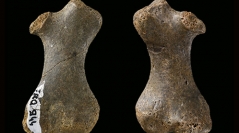

 Geodiversitas
38 (2) - Pages 197-224
Geodiversitas
38 (2) - Pages 197-224The locality of Küçükçekmece has yielded a unique carnivoran fauna representing one of the rare fossil assemblages comprising both marine and terrestrial species. The studied sample comprises thirty-four specimens belonging to three different collections at the Technical University of Istanbul (ITU), Geology Museum of the Istanbul University (IU) and at the National Museum of Natural History of Paris. This low number of fossil remains contrasts with the relatively great taxonomic richness of the fauna, since six families and at least nine species are identified: the ursid Indarctos arctoides (Depéret, 1895), the mustelid Sivaonyx hessicus (Lydekker, 1884), the phocids Cryptophoca sp. and Phocidae gen. et sp. indet., the percrocutid Dinocrocuta senyureki (Ozansoy, 1957), the hyaenid cf. Thalassictis sp., the felids Machairodus aphanistus (Kaup, 1832), Pristifelis sp. cf. P. attica (Wagner, 1857) and Felidae gen. et sp. indet. medium size. A tenth species, a small mustelid identified as Mustela pentelici Gaudry, 1861 by Malik & Nafiz (1933), was probably present. However, the figured (and only?) specimen was destroyed during the 1942 fire at Istanbul University. Most of the species are documented by one or a few specimens, while the phocid material is the most abundant and represents more than half of the described fossils, with many postcranial remains. The list of Carnivora of Küçükçekmece suggests a late Miocene age for the fauna of this site.
Miocene, Turkey, Carnivora, Ursidae, Mustelidae, Phocidae, Hyaenidae, Percrocutidae, Felidae.